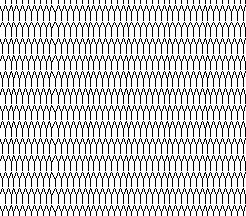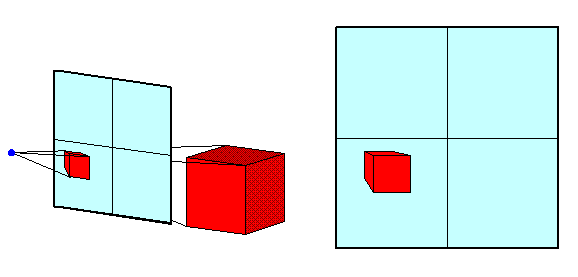Rungs and Vineyards

The Rungs
 The image
at the top of this page is an animated GIF. It simulates an interesting
visual phenomenon, one which you may have observed yourself. I used to
always notice it when I lived in Anacortes, Washington, which is on Fidalgo
Island, on Rosario Strait. The island is separated from the mainland by
a narrow channel, and Route 20 has a bridge crossing the channel. On the
north side of that bridge is a pedestrian path with guardrails on both
sides. The rails have uniformly spaced, vertical rungs. The image
at the top of this page is an animated GIF. It simulates an interesting
visual phenomenon, one which you may have observed yourself. I used to
always notice it when I lived in Anacortes, Washington, which is on Fidalgo
Island, on Rosario Strait. The island is separated from the mainland by
a narrow channel, and Route 20 has a bridge crossing the channel. On the
north side of that bridge is a pedestrian path with guardrails on both
sides. The rails have uniformly spaced, vertical rungs.
If you live near that bridge, go watch what happens when you drive across
it at 55 miles per hour (advisable, since it is a speed trap). You are
looking through both guardrails at the same time. At that speed, it is
difficult to see any individual rungs. They become blurred. There is the
illusion of much larger rungs, widely spaced. You can see between them,
but you cannot see through them. What’s more, these phantom rungs appear
to be moving with the car. What causes that?

The animated GIF shows a perspective sketch of two rows of rungs moving
left to right. It may help to stand back a few feet from the screen. You
should see the illusion of several stationary objects, although all of
the objects are in motion. Open the Java applet rungsani.htm.
It allows you to change the perspective of the observer, and the size and
spacing of the rungs.

Let us consider what it is that prevents us from seeing through both
rows. In this illustration, we see an overhead view of the two rows of
rungs. The pedestrian path is between them. Of course it is possible to
see through a single row. Simply look between the rungs. The green arrows
represent parallel sight lines. They are oriented in a direction such that
each rung on the north row is directly behind a rung on the south row.
Looking in this direction, the north row cannot even be seen, so it is
easy to find an unobstructed view.
Now look at the red arrows. They too are parallel sight lines, but with
a different orientation. This time the rungs of the north row line up with
the spaces of the south row. Even if you look between the south rungs,
your line of sight will probably be obstructed by one of the north rungs.
It appears the sight lines will be the clearest when we look in a direction
such that the rungs of one row line up with the rungs of the other row.
The direction of sight is what matters, not our position on the bridge.
That is why the phantom obstructions appear to be moving with the car.

Can we compute a formula for the directions of the sight windows? Clearly,
if we look directly north, perpendicular to the guardrails, the rungs will
line up. That would be the direction from A to B in the sketch
above. Now turn to the left. The rungs will not line up again until we
look in a direction parallel to AC. The angle we turned is ∠BAC.
What is the measure of that angle (the northwest bearing)? Let r
be the space between the rungs, and let s be the distance between
the guardrails.

There are other sight windows. We could look in a direction parallel
to AD, or AE, or AF. To find those bearings, compute
the measures of ∠BAD, ∠BAE,
and ∠BAF. Those angles are tan-1(2r/s), tan-1(3r/s), and tan-1(4r/s). In fact, there will be a sight window at angle tan-1(nr/s),
for any integer n. The angles between these windows will not be
equal, but, from our perspective, they appear to be evenly spaced along
the bridge.
What happens to the visual effect if we get further away from the
guardrails?
What would happen if the rung spacing on one guardrail were slightly
different than the spacing on the other?
The illusion created by this situation is called a moiré effect.
In this case, its occurrence was incidental. Research moiré effect
to find how similar illusions can be created purposely.
 Extension: Extension:
This is something I noticed a few weeks after I wrote the explanation
above. Look at this photograph. It is the belfry of Gerberding Hall,
on the University of Washington campus. The openings are covered with steel
webbing in order to keep out the pigeons and bats. Look closely through
the opening. You are looking through two layers of the webbing. One is
closer than the other. The pattern of the webbing is much too small to
see at this distance, but the two layers create an interference pattern,
which is very noticable.
 The image at right
is an approximation of the pattern of the webbing. If you have the Geometer’s
Sketchpad, or some other appropriate software, try duplicating the pattern.
Then dilate it by a factor of, say, 1.2. When the two patterns are overlaid,
it should create an interference effect similar to the one in the belfry.
Try the same thing with other patterns, such as a square grid, or a honeycomb. The image at right
is an approximation of the pattern of the webbing. If you have the Geometer’s
Sketchpad, or some other appropriate software, try duplicating the pattern.
Then dilate it by a factor of, say, 1.2. When the two patterns are overlaid,
it should create an interference effect similar to the one in the belfry.
Try the same thing with other patterns, such as a square grid, or a honeycomb.
The Vineyards
Here is a related topic. This one I noticed while driving through California
on Highway 101. It’s remarkable that I have such a clean driving record
when I pay so little attention to the road. So anyway, 101 goes through
a lot of vineyards and orchards. They are always laid out in a square grid
pattern. Maybe that is the most efficient use of space. Whatever the reason,
it must be important to them, because the plants appear to have been staked
very precisely.
When I drive by and look straight up to rows, they appear to open up.
In that direction, I can follow a row, with my eyes, all the way to the
end of the field. Try it yourself. If you keep looking in that direction,
all of the rows will go past and open up right there. This is an effect
I used to notice with the corn rows in my native Illinois. But in the vineyards,
it gets even better. You can turn your eyes 45° and see a similar effect
along the diagonals. Next try looking up one plant and over two. You will
see rows of plants in that direction too. In fact, if you can line up any
two plants, you will see a whole row of plants in that direction, but some
are easier to see than others.
The first sketch below is an overhead view of the vineyard. Below it
is a perspective drawing of the same vineyard, viewed from a point just
above the tops of the plants. Same of the plants that line up are color
coded, so that they can be seen in both sketches. When they line up, they
appear as a single vertical line in the perspective drawing.


There is a Sketchpad file to go with this one too. Open vineyard.htm and experiment with it. Change the position of the observer, and change
the heights of the eye level and the plants. When you move the observer
across the screen, it should look similar to the vineyard viewed from
a moving car. It is even possible to drive through the vineyard, but please do not attempt this in real life.
If you are looking for practical applications, you may be reading the
wrong web page. I brought this up only because I find it interesting. Here
are a few things to think about.
Assume a vineyard on a plane infinitely wide and deep. Is it possible
to find a row of plants for any given direction?
How can these plant rows be used to model the set of rational numbers?
Perspective
Both of the Sketchpad files on this page have perspective drawings.
The astute observer will have noticed that they are quite different. rungsani.htm
was used for the animated drawing at the top of the page. See how the rungs
grow in size as they get closer to the observer. But what about vineyard.htm?
All of the plants in the front row have the same height, but if they lie
on the same line, they cannot all be the same distance from the observer.
Which is correct? Neither. Which is better? Take your pick.

The sketch of the rungs approximated a cylindrical projection.
Imagine the observer as a point on the axis of a vertical cylinder. Now
consider a ray, originating at the observer and passing through a point
on the object to be plotted. That point will be projected to the point
where the ray intersects the cylinder. After all of the points of interest
have been projected onto the cylinder, it is unrolled and laid flat.

The vineyard was drawn using a planar projection. This concept
is a bit simpler. Have the ray intersect a plane instead of a cylinder.
The Sketchpad file creates the projection mathematically, but you can easily
create one optically. With one eye open, look out a window. Hold your head
perfectly still, and trace outside objects onto the glass. The drawing
is a planar projection.

In the vineyard drawings, the images of all of the plants in the
front row have the same height, even though some are further away than
others. But the images of the plants in the back rows are smaller, just
as we would expect. Why is that?
In the cylindrical projection, will all straight lines be projected
as straight lines? Which lines will and which will not? What about the
planar projection?
Could you create one of these projections from the other?
Consider the advantages of each of these projections. Cartographers
use planar and cylindrical projections, and many others, to represent a
curved surface (Earth and other planets) on a flat map. Many of their projections
cannot be described with a simple geometric model.
Geometer’s Sketchpad Files
The Java applets presented here were created with the Geometer’s Sketchpad
(version 3). The original Sketchpad files may be downloaded here:
 rungs.gsp
rungs.gsp
 vineyard.gsp
vineyard.gsp
Back to Whistler Alley Mathematics
Last update: January 26, 2012 ... Paul Kunkel whistling@whistleralley.com
For email to reach me, the word geometry must appear in the body of the message.
|